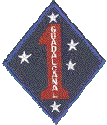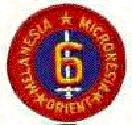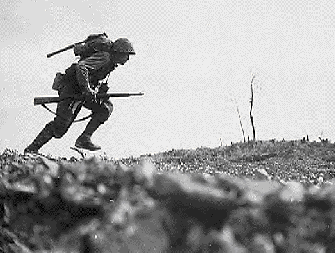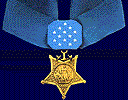Battle For Okinawa: World War II | Main Site
Historical Perspectives Page: Okinawa Part II
The Battle for Okinawa
     |
World War II - Okinawa
' The Old Breed '
More than 80,000 US Marines helped smash the Japanese defenses on Okinawa in an 82-day battle. The first of the Marines landed 1 April 1945.
 LST 494 Association
|
That first day--Love-Day--happened to be Easter Sunday and also April Fools' Day. As part of the 10th Army, Leathernecks of the 1st and 6th Marine Divisions had landed virtually unopposed, while the 2d Marine Division made a feint landing off the Southeast Coast of the island. Ironically, it was the 2d Division which suffered the first casualties on L-Day--8 Marines killed, 37 wounded, and 8 missing in action. Two days later enemy resistance stiffened as the Marines wheeled inland to the northern part of Okinawa.
There were slightly more than 100,000 Japanese waiting to oppose American forces attempting to take Okinawa. The enemy had elected not to defend his beaches and had instead chosen a stand from heavily fortified inland defenses.
As 1st Division Marines pushed across the island, the 6th Marine Division began to sweep northward to the Motobu Peninsula. The new division ran up against a force of sane 2,000 Japanese manning a well-organized defense system built around the 1,200-foot Yae Take Mountain.
Men of the 29th Marines pushed onto the peninsula 9 April, and promptly ran into opposition which made it clear that the peninsula was not to be taken by a single regiment. The 4th Marines joined the fight and together the two units fought an arduous four-day campaign before completing the capture of northern Okinawa.
The week on Motobu was characterized by-tactical originality, aggressiveness, and maximum use of every kind of supporting fire that was available. Artillery armored amphibians, and aviation continually dueled with Japanese artillery.
Large naval guns poured heavy fire on the enemy in support of the 6th Division. A message sent to Navy ships supporting the operation stated: "The effectiveness of your gunfire support was measured by the large numbers of Japanese encountered. 'Dead ones'."
The Marines had completed their first chore on Okinawa. Marine artillery men had been engaged in the fight towards the southern half of the island since mid-April. The 11th Marines had been detached to reinforce the artillery fires of two Army divisions and were in the thick of what was shaping up to be an artillery man's battle.
The 1st Marine Division had been placed in 10th Army Reserve 24 April, leaving III Corps with one Marine division. On 1 May the 1st Marine Division was assigned to the American line and took the job of maintaining the right flank. The Marines were again fighting as the III Amphibious Corps.
US forces pushed slowly forward as the war on the ground continued virtually unhampered by enemy air. Marine aviators flew through the Okinawan skies maintaining air supremacy throughout the campaign, while, at the same time, attempting to blunt the Kamikaze menace.
More than 12,000 Marines from the Corps, aviation army fought at Okinawa in 22 shore-based squadrons, 10 carrier squadrons, 5 air-warning squadrons, and a miscellany of headquarters and service units. Most of this effort--but not all--came under the Marine -commanded Tactical Air Force (TAF) of the 10th Army.
Marine aviators flew from Yomitan Airfield which had been secured by III Corps troops on the first day of the assault. The Marine pilots flew a variety of missions which ranged from close air support to combat air patrols miles away from Okinawa.
The Navy brought more than 1,200 ships to Okinawa, and against these ships blew the Divine Wing . . . Kamikazes. The Kamikaze pilots were trained for only two things: to take off from a base and to crash into a US ship. For the latter, they needed little training.
The first wave of the Japanese planes arrived 6 April and was 355 strong. Fighters promptly disposed of 17 enemy aircraft with the ships, guns having a field day with the massed planes. Only 22 enemy planes got past the fighters and flak. They hit 22 US ships, 3 of which were sunk.
About 40 percent of the close air support missions flown against the enemy on Okinawa were carried out by Marines. The aviators often raked enemy positions scant yards from American lines with rockets, napalm, and bullets. And the Marines furnished supplies by air when Okinawa's network of dirt roads turned to knee-deep mud during the island's rainy season.
Detachments of Marine air warning squadrons used their radar to direct Army, Marine, and Navy pilots on intercept missions both day and night. By 30 June, TAF had downed 600 Japanese planes. Marine pilots accounted for 484 of these.
While Marine aviators were racking up impressive scores in the air, Marine infantrymen slogged through the mud in their combined push with the Army to the south.
On 14 May the 22d Marines butted against Sugar Loaf Hill and after being joined by the 29th Marines fought furiously for six days before capturing the hill. After the hill had fallen, 40 Marines stayed on top during repeated counterattacks by overwhelming Japanese forces.
From Sugar Loaf, the attack pressed forward with the 4th Marines--fresh from a short rest--in the lead. After forcing a river crossing the regiment reached the outskirts of Naha, principal port on the west coast.
 A Marine dashes across a draw
nicknamed 'Death Valley'
During heavy fighting in May; in 8 hrs the Marines took 125 Casualties here
(National Archives Photo; Used with Permission)
|
The fight continued along the coast until 31 May when the 1st Marine Division and 77th Infantry Division completed the occupation of the Shuri Castle bastion which had held out for a bloody month of fighting.
The bulk of Okinawa's defenders fell back slowly to the island's southern tip for a last stand. A small Japanese naval garrison clung stubbornly to Oroku Peninsula, which juts from the west shore south of Naha.
Oroku contained a large airfield and, more important, it flanked the US advance. The 6th Marine Division under took the chore of capturing the peninsula by means of an amphibious assault.
The division landed in the gray dawn of 4 June against a driving rain and a diehard enemy. In 10 days, steady fighting, that was slowed by mud and minefields, the division compressed the enemy into a pocket and annihilated them.
Marines of the 1st Division maintained the coastal flank of the American assault. Ahead of the division lay steep Kunishi Ridge fronted by a half mile of flat open fields and rice paddies. It was held by a large enemy force.
Daylight attacks of the 7th Marines were supported by superb tank assaults. They failed to dislodge the enemy and a night attack was planned for 0330, 12 June. It worked and two companies of Marines got across the fire-swept flats before daylight. The following night saw the remainder of the regiment join the two companies. Now the Japanese were inside the ridge with the Marines on top. A fierce four-day battle raged in which 21 Marine tanks were lost.
Kunishi fell to the 7th Marines on 17 June while the 6th Marine Division was resuming its former position on the American flank. The bone-weary 7th was relieved by the 8th Marines (2d Marine Division) which immediately pushed southward with the vigor of a fresh outfit.
On 18 June, just as the campaign was nearing a close, Army Lieutenant General Simon B. Buckner was killed while observing the 8th Marines' attack. He was the Commanding General of the 10th Army which had assaulted Okinawa. General Buckner was replaced by Lieutenant General Roy S. Geiger, who was commanding at the time of the island's fall on 22 June. General Geiger, a pioneer Marine aviator, had become the first Marine general officer to command a land force the size of an army.
Okinawa had cost the Marine Corps--including ships, detachments and aviation--3,430 killed and 15,723 wounded. An additional 560 Navy doctors and hospital corpsmen fighting with the Marines were killed or wounded.
Overall American losses in the land battle amounted to 7,374 killed, 31,807 wounded and 239 missing in action. At sea and in the air, the Navy reported 36 US ships sunk, 368 damaged, 763 aircraft lost to all causes, 4,907 seamen killed or missing in action and 4,824 wounded.
The Japanese-suffered more losses at Okinawa than they had in any previous Pacific battle. They lost 7,830 planes, and 16 combatant ships. Japanese soldiers and seamen ashore on Okinawa played the grim price of 107,539 counted dead, 23,764 sealed off in caves and 10,755 taken prisoner. Many of the dead were civilians, innocent victims of the bitter fighting.
The price America paid for Okinawa was grim but necessary. Okinawa was to have become the springboard from which the U. S. would have launched the assault on Japan. More than a million soldiers, Marines, and sailors would have been used in the attack on Japan had the atomic bomb not secured an early end to the war.
Reference Section
Marine Corps Historical Center
1998
Congressional Medal of Honor

SGT ELBERT LUTHER KINSER
A First-Hand Account
USMC 6/4 on Okinawa
The Way I Remember the Landing in Okinawa
By John E. Bogers USMC
Congressional Medal of Honor

FRED FAULKNER LESTER
(1) Unit Insignia: 1st Marine Division, 2nd Marine Division, 6th Marine Division, 77th Infantry Division
(3) History of the 77th: The 77th Infantry Division Association
(5) Public Domain: SJ Wilden Photo from FindaGrave
(6) Public Domain US Armed Forces Photo Provided to Okinawan Prefecture
(7) Public Domain US Armed Forces Photo Provided to Okinawan Prefecture
(9) Public Domain; Photo used with Permission
(10) Source unknown public domain US 10th Army Records
(11) US Army Strategic Bombing Survey 1946
(13) http://www.army.mil/cmh-pg/books/wwii/72-14/72-14.htm